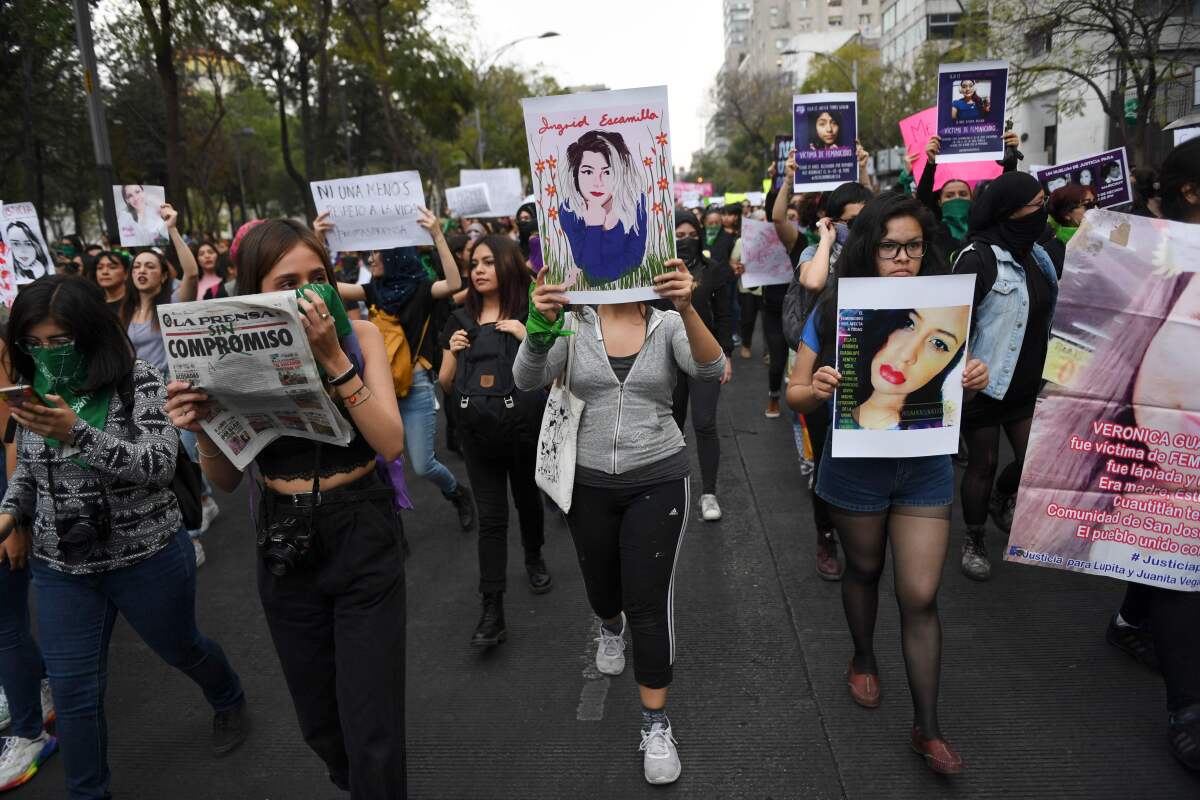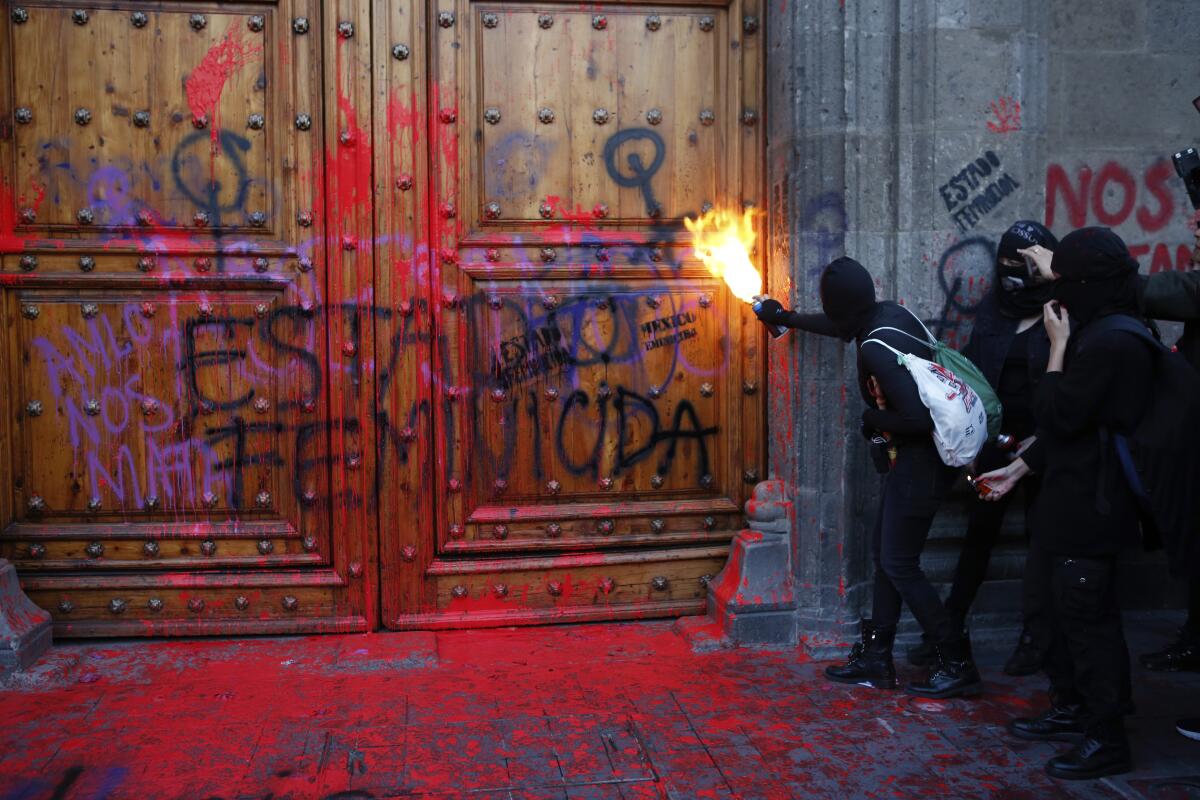In Mexico, a grisly killing inflames debate about femicide
- Share via
MEXICO CITY — She was one more victim here in a growing wave of femicide — the killing of women because of their gender.
But the gruesome slaying last weekend of Ingrid Escamilla, 25, in the Mexican capital set off a firestorm of protest following the publication of forensic photographs of her mutilated body that were leaked to the media.
In one case, a Mexican tabloid published photographs with the headline: “It was Cupid’s fault,” an apparent reference to Valentine’s Day.
The publications of the images “made her a victim anew and gave justification to the aggressor,” said a Twitter post by Mexico’s Museum of Memory and Tolerance. “The victims of macho violence need justice and the ethical response of the media and society.”
In Mexico, as in other Latin American nations, feminists, human rights advocates and others have long argued that the murder of women has not been a law enforcement priority.
Of the 35,558 homicides recorded in Mexico last year, 3,825 of the victims were female. A total of 1,006 killings were officially classified as femicides, based on a variety of criteria, including whether the victim’s body showed any signs of sexual violence and whether there had been a “sentimental” or “close” relationship between the victim and the suspect.
The femicide total — which is incomplete, because several states still do not use the designation — marks a 145% jump over the 411 cases in 2015. The increase significantly exceeds the rapid rise in the country’s overall homicide rate.
Escamilla was found dead in an apartment in the capital on Sunday, apparently stabbed to death. Her body had been partially skinned and some organs removed, police said.

A 46-year-old man who was reportedly her romantic partner has been arrested in connection with the case. Footage, apparently leaked by police, shows the suspect bloodied and admitting to the killing.
Prosecutors said they would seek the maximum penalty, 60 years imprisonment. That includes 10 years that can be tacked on when a killing is designated a femicide.
President Andrés Manuel López Obrador told reporters he supported women’s desire to see greater justice for gender crimes.
“We celebrate that women defend their right to security,” he said. “I pronounce myself in favor of women, and against femicide.”
He also condemned the leak of the forensic photographs as a crime as authorities announced an investigation to find out who was responsible.
The case immediately launched a debate over its wider implications.
“Who killed Ingrid Escamilla?” read a headline on a column in El Universal newspaper written by Alejandro Hope, a political science professor. “A violent and machismo culture killed Ingrid, our indifference killed her, our failure to demand that things change killed her.”
In Mexico, Hope noted in the column, only 1 in 10 cases of homicides of women result in a guilty verdict.
“Femicide is an absolutely reprehensible crime,” Claudia Sheinbaum, the mayor of Mexico City, wrote on Twitter. “It is absolutely appalling when hatred reaches the extremes as in the case of Ingrid Escamilla.”
As the controversy has grown, more details have emerged about Escamilla, whose life story — that of a well-educated young women from the provinces who comes to work in the capital — reflects that of many young residents of Mexico City.
She was a native of a poor mountain town in central Puebla state who had a master’s degree in tourist business administration. One of five daughters — including a twin sister — she was described in social media posts as a lover of animals and of Harry Potter.
In 2017, according to various media accounts, Escamilla volunteered for reconstruction work in the earthquake-battered town of Jojutla de Juárez in Morelos state, and urged acquaintances on social media to come help “rebuild Mexico.”
She had been a teenage beauty queen in her home town of Nueva Necaxa Canaditas, where she was buried this week.

On Friday, women staged several marches in the Mexican capital, including a large gathering in front of Bellas Artes, the capital’s premier cultural venue. Hundreds of women police were on hand to keep order.
Some groups shouted: “The machistas tremble because Latin America will be totally feminist!”
Laura Torres Diaz, 21, a law student who protested, said: “We demand an end to femicide. And that violence against women is stopped. They are killing us, they are raping us, they ‘disappear’ us and no one does anything. Enough already.”
Karla Soto, 19, a sociology student, declared: “We are all Ingrid.”
“We are all victims of violence. They kill us with total impunity and the authorities laugh at our protests, the president jokes about our pain,” she said.
Some protesters marched to the headquarters of La Prensa, one of the newspapers that published photos of Escamilla’s body. Police in riot gear met them at the newspaper building, but at least one newspaper delivery truck went up in flames, footage from the scene showed.
To counter the grisly images of Escamilla’s body, a Twitter campaign emerged in which people posted “beautiful” photographs of the victim looking content and wearing bright lipstick with hashtags such as #JusticeForIngrid. Some also chose images of calm seas and sunsets, cats and rainbows.
“The world needs to know #IngridEscamilla and remember her beautiful life!” wrote one woman.
Times staff writer Julia Barajas in Los Angeles and special correspondent Liliana Nieto del Rio in Mexico City contributed to this report.
More to Read
Sign up for Essential California
The most important California stories and recommendations in your inbox every morning.
You may occasionally receive promotional content from the Los Angeles Times.










